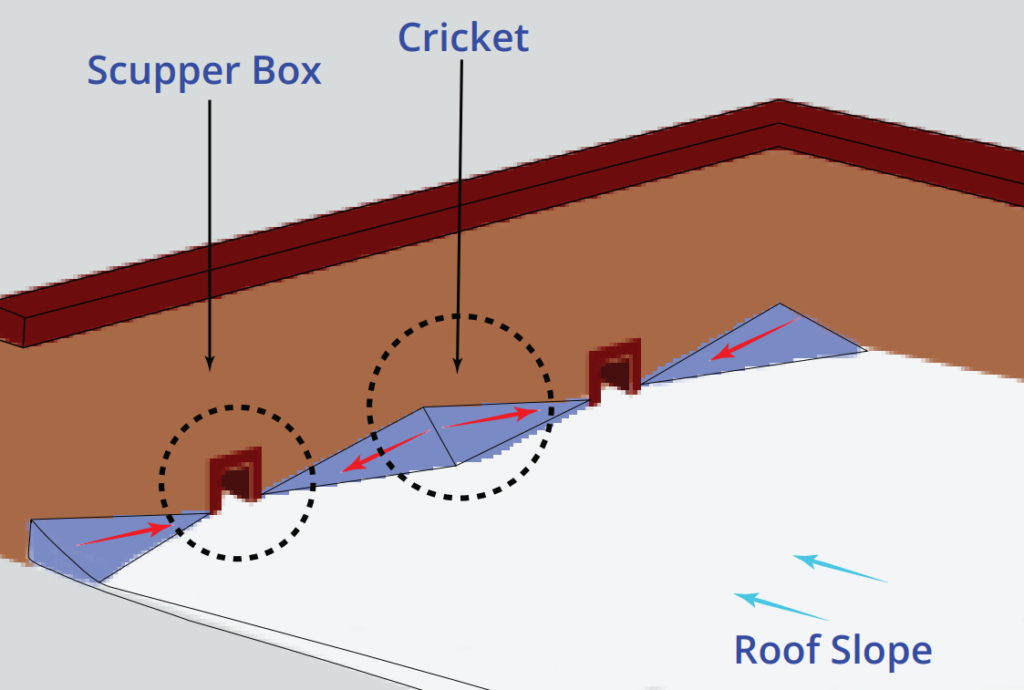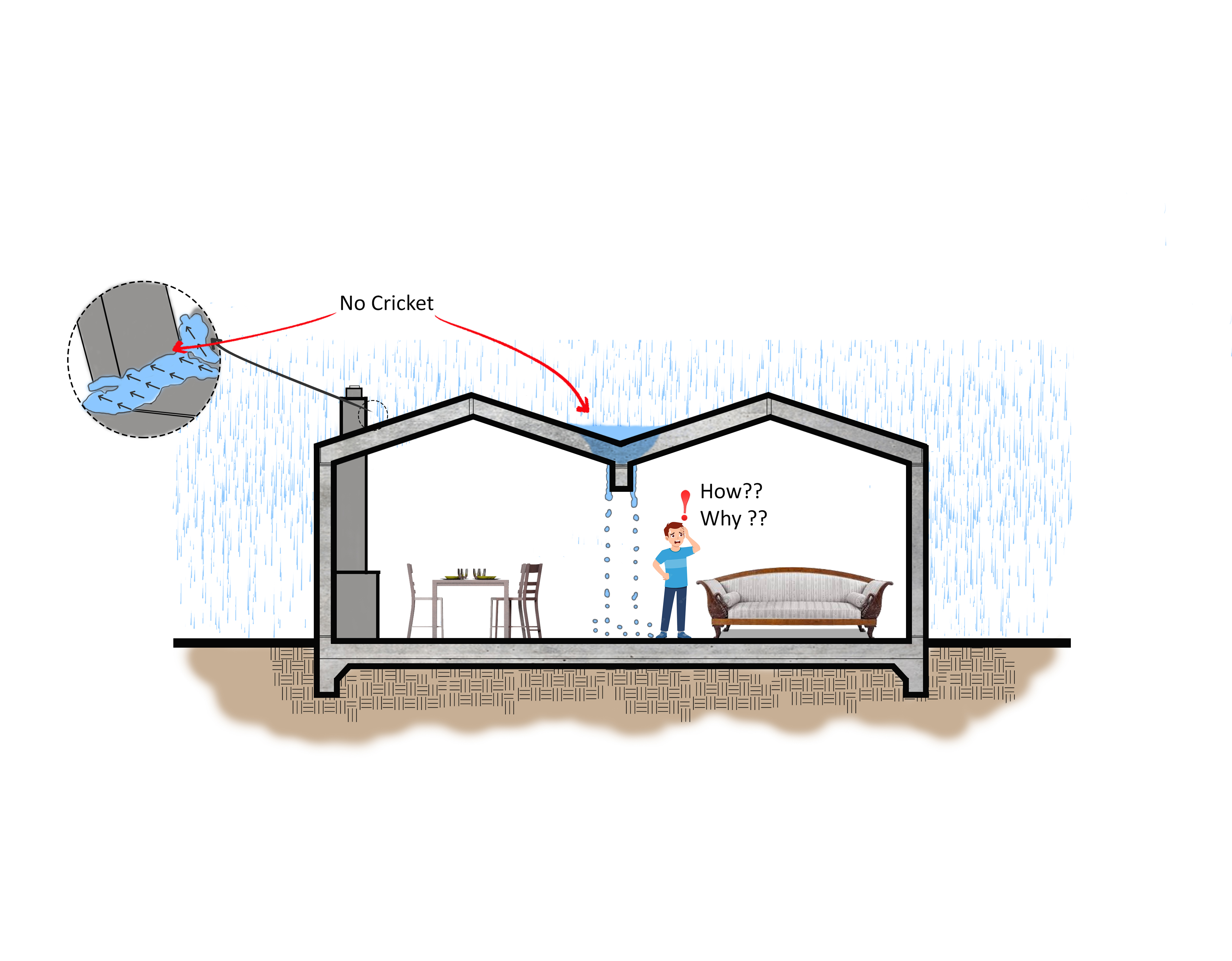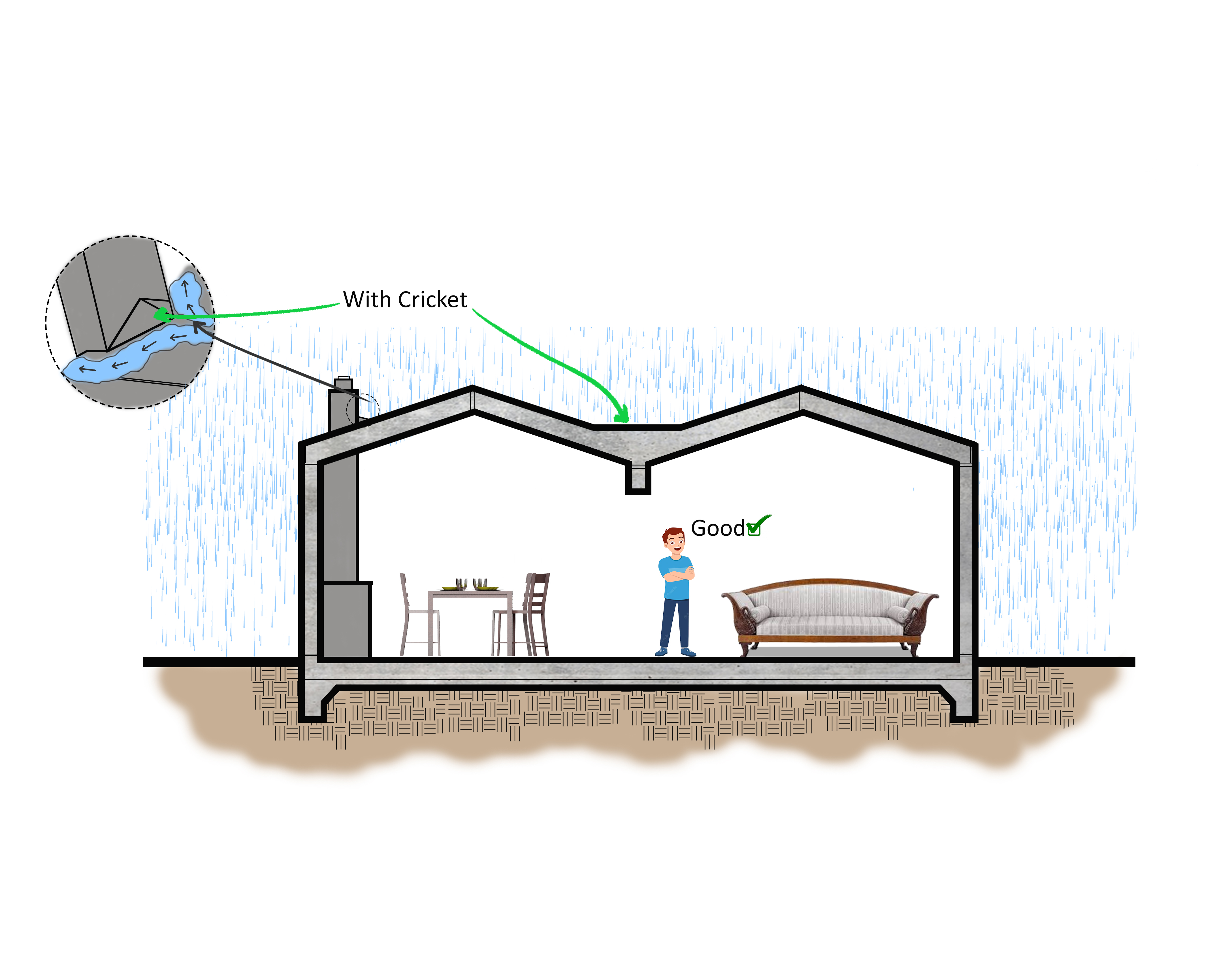What is Cricket on roof?
A cricket, or saddle, in construction, is a triangular structure constructed to divert the surface water from the roof to the drains. It is designed on a flat or pitched roof mainly around the chimney, roof edges, curbs (Skylights and HVAC), drains, or wherever a 90° angle is formed on the roof. The main purpose of the cricket is to divert the water from the low slope and flat roofs with the parapet wall to the drain. A minimum of 2% of the slope is required for the water to drain smoothly, but cricket is more crucial to divert the water and also to protect the edges from penetration of water, which can lead to leakage and structure failure.
For steep slope roofs, it is advantageous to have a cricket pitch that is equal to or less than the present roof so that it has at least a 50% bigger slope than the actual roof to avoid water ponding on the roof. When water accumulates on a roof, it transports all of the debris and filth with it. Cricket can be designed or constructed with metal, wood, and concrete.
Places where cricket can be constructed
Roof crickets are constructed to divert the standing water from the flat roof and pitched roof. Given below are some places where we should design roof crickets.
- Parapet walls or Walls
- Curbs: Skylight, Gable window, and HVAC
- Drains
Roof cricket near the parapet wall
The parapet walls are intended to handle rainfall and protect the roof’s edges. Flat roofs are designed to guide rainfall to drains or scuppers, although not all of the rainwater reaches the drain. There is a potential that some water will stay on the roof. Roof crickets are employed to channel rainfall towards the scupper to counteract this. It works, as seen in fig. 1. Roof crickets guard the margins of the parapet wall and the mid-wall.
Roof cricket around Skylight and HVAC
Cricket is not just used to divert the rainwater towards the drains; it is also used to protect the edges so that rainwater doesn’t harm the structure and penetrate the building. Roof cricket is also required for chimneys, HVAC systems, skylights, and other applications because there might be a chance that the rainwater remains around the HVAC unit and harms it. As you can see in fig. 2, we can construct a cricket around the HVAC to protect it from failure.
Roof cricket between the Drains or Scuppers
Drains can be placed anywhere on the roof, at the edges, or in the middle. It depends on the slope of the roof, which leads to rainwater. Wherever you place a drain or scupper, it requires roof cricket so that water doesn’t remain on the roof. See fig. 3 below for how it should be placed. Many roofs don’t have roof crickets. That’s why you can see green or black patches on them. Crickets should be used to avoid these patches.



The shapes in which crickets are designed
- Quarter Diamond
- Half Diamond
- Full Diamond
Design considerations for the installation of roof crickets
Slope of the roof :- A cricket can be installed on any surface, whether it is flat or pitched. While installing on a pitched roof the slope needs to be considered. For better water drainage a slope of ¼ inch per foot is preferred. It can vary depends on the size and pitch of the adjacent roof sections. And also depends on the local building code and climatic conditions.
Hire a professional who can deal in this kind of situation, he will advice you in better way as per your site considerations.
Shape and size of the components (chimney, HVAC, drain, etc.) :- The size of the roof cricket can vary as per the components or location where you are going to install it. Slope may also vary with the change in situations.
Roofing material and weather conditions:- Select a material that is durable, long-lasting, and weather-resistance. Going with the material that doesn’t go with your site conditions will not benefits you in any way. It will just harm your roof and reduce its efficiency.
Cost of installation of the roof cricket: A roof cricket has several options as per material preferences, and the cost can vary. But the estimated cost of installation can range from 150 to 500 dollars (12,000 to 42000 rupees) for a brand new roof cricket. During the roof repair project, it can cost between 700 and 1000 dollars (58,000 and 83000 rupees). [1] The amount can vary from place to place depending on the condition of your roof. Consult an agency for a proper cost breakdown.
What type of materials are used for roof cricket?
Not always different or specialized materials are required for roof cricket. We can use the roofing material that has been used for the roof to make the roof cricket. It will also be convenient for you, and the same material will make the roof flush with the roof. If you want to enhance the aesthetics of the roof by using different materials for the roof, then you can opt for the same type of shingles used for your asphalt roof, meta flashing, wood, clay, slate, PVC, copper, galvanized steel, aluminum, or a piece of membrane. Copper, aluminum, and galvanized steel are very good options for roof cricket as they don’t rust or corrode in the presence of water. They are also resistant to fire and insects.
Smaller crickets (on steep sloped roofs only) can be covered with metal flashing, and larger ones can be covered with the same material used for the roof.
Where do we need roof cricket?
- Above a flat roof, on a slope.
- Around the edges of the chimney, HVAC units, skylights, Vent Pipes, etc.
- At any vertical edge or junction.
Advantages
- Cricket diverts the flow of water.
- It protects the roof from water damage, roof sagging, rot, mildew or mold, etc.
- It stops the leakage of water and protects the structure from failure.
- Avoid ponding on the roof.
- This reduces the chances of green or black patches on the roof.
- It can be used to improve the aesthetics of the roof.
- It extends the roof lifespan by protecting it.
- Having a roof cricket will save you money in future water leak situations.














2 Responses
Great illustration and info
Thank You
Thank you for your kind words! I’m glad you found the illustration and information helpful.